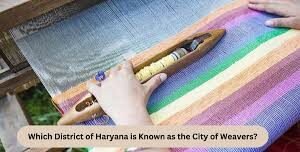City of Weavers: Which District of Haryana is Known for Its Rich Weaving Tradition?
Haryana, a state known for its cultural richness and vibrant heritage, is home to many districts with unique identities. One such district, known as the “City of Weavers,” is Panipat. The district, renowned for its weaving industry, has earned this title due to its deep historical connection to textiles and the significant contribution it makes to India’s handloom industry.
Panipat is not just famous for its textiles but also for the diversity and quality of products it offers, ranging from carpets to handloom fabrics. The city’s thriving weaving industry has been pivotal in supporting both the local economy and India’s reputation in the global textile market.
Importance of Panipat in India’s Handloom Industry
Panipat’s contribution to India’s textile industry cannot be overstated. Known for its weaving and textile industries, it is the largest exporter of handloom products in India. The district plays a crucial role in the global market for handwoven carpets, bed covers, and other fabric-based goods.
Moreover, Panipat’s textile sector provides employment to thousands of people, many of whom are skilled artisans involved in the intricate art of weaving. The city’s role as the “City of Weavers” has allowed it to become one of the key commercial hubs for textiles in India, with markets that attract both domestic and international buyers.

Why This News is Important:
Economic Contribution
The news about Panipat being known as the “City of Weavers” is important because it highlights the city’s contribution to India’s economy, especially the handloom sector. Panipat’s weaving industry generates substantial revenue and plays a pivotal role in employment generation, particularly in rural areas. It supports the livelihoods of many artisans, providing a steady income and boosting the local economy.
Cultural Heritage
Understanding the importance of Panipat as the “City of Weavers” offers insight into India’s cultural heritage, where traditional craftsmanship coexists with modern industry. This reinforces the need to preserve India’s centuries-old weaving techniques while encouraging innovation to keep pace with global demands.
Relevance to Government Exams
This news is crucial for students preparing for government exams as it reflects the significance of the handicrafts and handloom industries, which are often part of questions in topics related to Indian economy, culture, and history. Knowledge about Panipat’s role in the textile industry provides a concrete example of how traditional industries contribute to national growth.
Historical Context:
Panipat’s association with textiles dates back to the Mughal era when the region became famous for its fine-quality fabrics and handwoven carpets. Over time, the district developed into a major textile hub, drawing artisans and traders from various parts of India and beyond.
During the 18th and 19th centuries, Panipat became synonymous with woven fabrics, especially carpets and bedding, which were exported worldwide. The weaving techniques were passed down through generations, with local artisans gaining a reputation for producing intricate designs. The city’s strategic location and access to raw materials like cotton and wool further supported its rise as a leading textile center.
Today, Panipat’s weaving industry thrives, with the traditional techniques being combined with modern machinery to meet the demands of a global market. Its history as the “City of Weavers” is celebrated not only for its craft but also for its contribution to the Indian economy, serving as a beacon of India’s rich textile heritage.
Key Takeaways from Panipat: The City of Weavers
| Serial No. | Key Takeaway |
|---|---|
| 1 | Panipat is known as the “City of Weavers” due to its rich tradition in the textile industry. |
| 2 | The district is a major exporter of handloom products, including carpets, bed covers, and other fabrics. |
| 3 | The weaving industry in Panipat plays a key role in India’s economy by providing employment to thousands. |
| 4 | Panipat has a historical legacy in textile production dating back to the Mughal era. |
| 5 | The city’s tradition of weaving continues to thrive, blending traditional techniques with modern industry practices. |
Important FAQs for Students from this News
What district of Haryana is known as the “City of Weavers”?
- Panipat is known as the “City of Weavers” due to its rich tradition in weaving and textile production.
Why is Panipat famous for its textile industry?
- Panipat is famous for its handloom products like carpets, bed covers, and other fabrics, making it a significant hub for textile exports.
What types of products are manufactured in Panipat’s weaving industry?
- Panipat is known for producing carpets, bed covers, handwoven fabrics, and other textile products that are exported worldwide.
How does Panipat’s weaving industry contribute to India’s economy?
- Panipat’s weaving industry generates significant revenue, supports local artisans, and provides employment opportunities, boosting the local and national economy.
What historical significance does Panipat hold in textile production?
- Panipat has a historical legacy in textile production that dates back to the Mughal era, making it one of the oldest and most renowned weaving centers in India.
Some Important Current Affairs Links


















